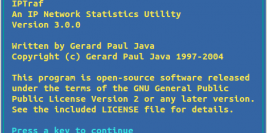iperf ເປັນເຄື່ອງມືສໍາລັບກວດກາອັດຕາການຮັບສົ່ງຂໍ້ມູນລະຫວ່າງເຄື່ງເຊີບເວີ 2 ເຄື່ອງໂດຍຈະກວດອັດຕາຄວາມໄວໃນການ transfer ຂໍ້ມູນລວມເຖິງສາມາດວິເຄາະຂໍ້ມູນພວກ packet loss ຕ່າງໆໄດ້ອີກດ້ວຍ
Iperf features
TCP
– Measure bandwidth
– Report MSS/MTU size and observed read sizes.
– Support for TCP window size via socket buffers.
– Multi-threaded if pthreads or Win32 threads are available. Client and server can have – multiple simultaneous connections.
UDP
– Client can create UDP streams of specified bandwidth.
– Measure packet loss
– Measure delay jitter
– Multicast capable
– Multi-threaded if pthreads are available. Client and server can have multiple simultaneous connections. (This doesn’t work in Windows.)
– Where appropriate, options can be specified with K (kilo-) and M (mega-) suffices. So 128K instead of 131072 bytes.
– Can run for specified time, rather than a set amount of data to transfer.
– Picks the best units for the size of data being reported.
– Server handles multiple connections, rather than quitting after a single test.
– Print periodic, intermediate bandwidth, jitter, and loss reports at specified intervals.
– Run the server as a daemon.
– Run the server as a Windows NT Service
– Use representative streams to test out how link layer compression affects your achievable bandwidth.
ຕິດຕັ້ງ iperf
ກະກຽມເຄື່ອງມືສໍາລັບການ make ກ່ອນ
|
|
yum group install“Development Tools”
|
Download ແລະ ຕິດຕັ້ງ iperf
|
|
wget http://downloads.es.net/pub/iperf/iperf-3.0.6.tar.gz
tar zxvf iperf–3.0.6.tar.gz
cd iperf–3.0.6
./configure
make
make install
|
Server 1
ເລີ່ມດ້ວຍການ start iperf3 ເຊິ່ງເຮັດໜ້າທີ່ເປັນ server mode
|
|
iperf3 –s
|
Server 2
ໃນສ່ວນນີ້ຈະເຮັດໜ້າທີ່ເປັນ client mode ເພື່ອທົດລອງ connection ໄປທີ່ server ທີ່ຣັນໄປດ້ວຍຄໍາສັ່ງ iperf3 -s
|
|
iperf3 –c x.x.x.x
|
ໃນຕົວຢ່າງຈະເຮັດໃຫ້ສາມາດຮັບຮູ້ເຖິງປະລິມານ bandwidth ທີ່ຮັບສົ່ງໄດ້ສູງສຸດໃນເວລານັ້ນໆ ອາດຈະເປັນອີກ 1 ຊ່ອງທາງໃນການວິເຄາະບັນຫາທາງເຄືອຂ່າຍຫາກເກີດເຫດການຜິດປົກກະຕິ
ອີກຕົວຢ່າງສໍາລັບຄົນທີ່ໃຊ້ການຮັບສົ່ງຂໍ້ມູນດ້ວຍ UDP ແລ້ວຢາກຈະສົ່ງ packet loss ກໍສາມາດໃຊ້ flag -u ເພື່ອຮົບສົ່ງຂໍ້ມູນດ້ວຍ UDP Protocal ໄດ້
Other useful flags:
-u Use UDP rather than TCP. See also the -b option.
-b, –bandwidth n[KM] – set target bandwidth to n bits/sec (default 1 Mbit/sec for UDP, unlimited for TCP).
-t, –time n – time in seconds to transmit for (default 10 secs)
-n, –bytes n[KM] – number of bytes to transmit (instead of -t)
-k, –blockcount n[KM] – number of blocks (packets) to transmit (instead of -t or -n)
-l, –length n[KM] – length of buffer to read or write (default 128 KB for TCP, 8KB for UDP)
-R, –reverse – run in reverse mode (server sends, client receives)
ຂໍ້ມູນເພີ່ມເຕີມ
https://iperf.fr









